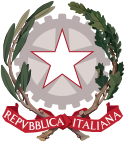
Back سياسة إيطاليا Arabic Política d'Italia AST Държавно устройство на Италия Bulgarian ইতালির রাজনীতি Bengali/Bangla Politický systém Itálie Czech Gwleidyddiaeth yr Eidal Welsh Politisches System Italiens German Πολιτικό σύστημα της Ιταλίας Greek Política de Italia Spanish Italian politiikka Finnish
Politics of Italy Sistema politico italiano | |
|---|---|
 | |
| Polity type | Unitary parliamentary republic |
| Constitution | Constitution of Italy |
| Legislative branch | |
| Name | Parliament |
| Type | Bicameral |
| Meeting place | Palazzo Madama Palazzo Montecitorio |
| Upper house | |
| Name | Senate |
| Presiding officer | Ignazio La Russa, President of the Senate |
| Lower house | |
| Name | Chamber of Deputies |
| Presiding officer | Lorenzo Fontana, President of the Chamber of Deputies |
| Executive branch | |
| Head of state | |
| Title | President |
| Currently | Sergio Mattarella |
| Appointer | Parliament |
| Head of government | |
| Title | Prime Minister |
| Currently | Giorgia Meloni |
| Appointer | President |
| Cabinet | |
| Name | Council of Ministers |
| Current cabinet | Meloni Cabinet |
| Leader | Prime Minister |
| Appointer | President |
| Headquarters | Palazzo Chigi |
| Ministries | 21 |
| Judicial branch | |
| Name | Judiciary |
| Supreme Court of Cassation | |
| Chief judge | Giovanni Mammone |
| Constitutional Court | |
| Chief judge | Silvana Sciarra |
| Part of the Politics series |
 |
|---|
|
|
The politics of Italy are conducted through a parliamentary republic with a multi-party system. Italy has been a democratic republic since 2 June 1946, when the monarchy was abolished by popular referendum and a constituent assembly, formed by the representatives of all the anti-fascist forces that contributed to the defeat of Nazi and Fascist forces during the liberation of Italy, was elected to draft a constitution, which was promulgated on 1 January 1948.
Executive power is exercised by the Council of Ministers, which is led by the Prime Minister, officially referred to as "President of the Council" (Presidente del Consiglio). Legislative power is vested primarily in the two houses of Parliament and secondarily in the Council of Ministers, which can introduce bills and holds the majority in both houses. The judiciary is independent of the executive and the legislative branches. It is headed by the High Council of the Judiciary, a body presided over by the President, who is the head of state, though this position is separate from all branches. The current president is Sergio Mattarella, and the current prime minister is Giorgia Meloni.
The Economist Intelligence Unit rated Italy as a "flawed democracy" in 2019.[1] According to the 2023 V-Dem Democracy indices Italy was the 21st most electoral democratic country in the world.[2] A high degree of fragmentation and instability, leading to often short-lived coalition governments, is characteristic of Italian politics.[3][4] Since the end of World War II in 1945, Italy has had 69 governments, at an average of one every 1.11 years.[5]
- ^ "Democracy Index 2019". Economist Intelligence Unit. Retrieved 23 November 2020.
- ^ V-Dem Institute (2023). "The V-Dem Dataset". Retrieved 14 October 2023.
- ^ Why is it so hard to form a government in Italy?: They designed it that way, The Economist (24 April 2013).
- ^ Explaining Italy's Fragmented Politics, Stratfor (18 April 2013).
- ^ "I Governi nelle Legislature" (in Italian). Governo Italiano Presidenza del Consiglio dei Ministri. 9 November 2015. Retrieved 27 April 2022.